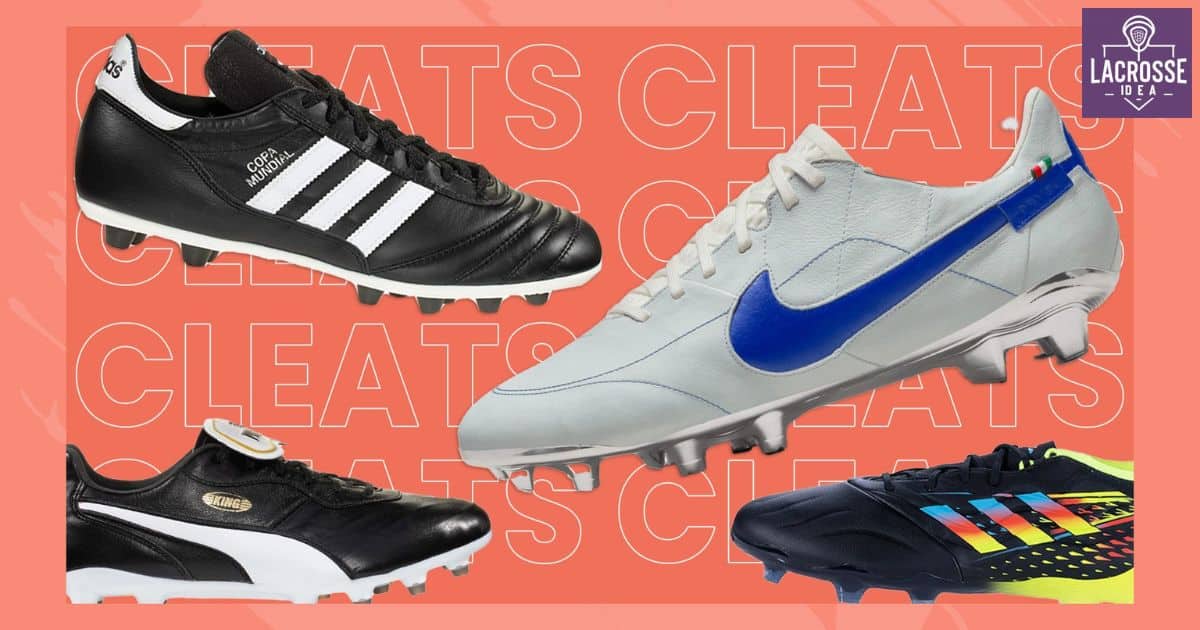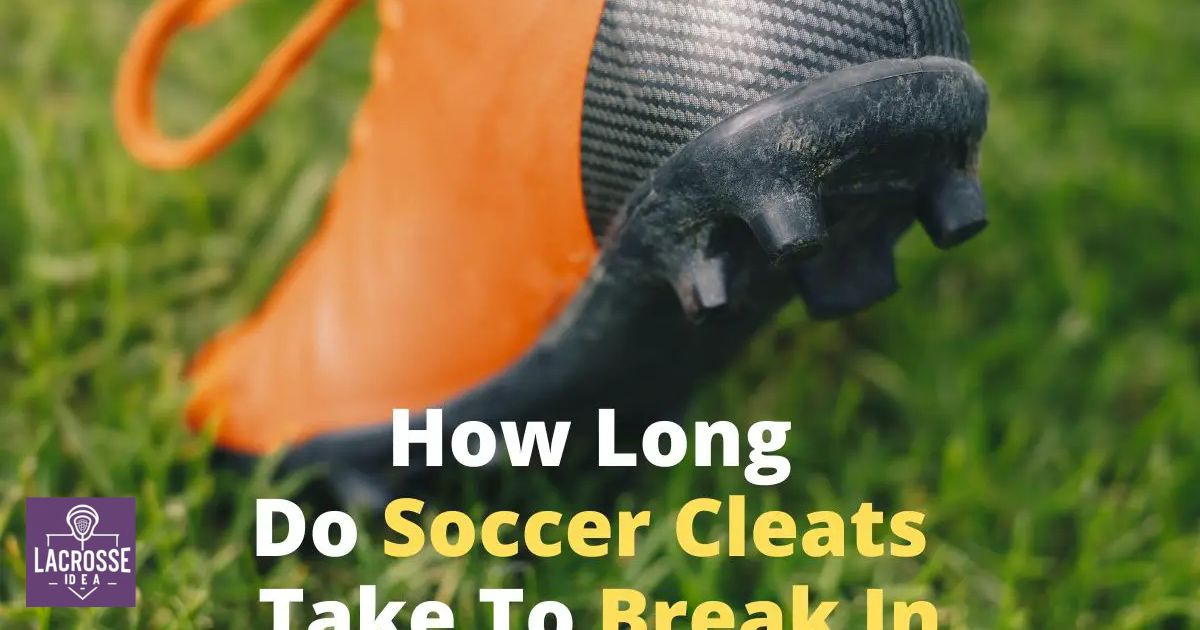In the world of sports, the right equipment can make all the difference in performance and safety. When it comes to the question of using soccer cleats for lacrosse, it is important to consider the specific requirements of each sport. Take, for example, the case of a lacrosse player who decided to try using soccer cleats during a game. This article explores the key differences between soccer and lacrosse cleats, highlighting the potential risks and impact on game performance.
Key Takeaways
- Lacrosse cleats have a higher ankle cut for better stability and support during lateral movements.
- Lacrosse cleats have a reinforced toe area to protect against stick checks and collisions.
- Lacrosse cleats have specialized traction patterns for superior grip on natural grass and artificial turf.
- Soccer cleats do not have the same ankle support as lacrosse cleats and do not offer the same level of toe protection.
The Difference Between Soccer And Lacrosse Cleats
The difference between soccer and lacrosse cleats lies in their respective designs and features. Understanding lacrosse footwear requirements is essential for players to perform at their best and ensure their safety on the field. Lacrosse cleats are designed with specific features to meet the demands of the sport. They typically have a higher ankle cut to provide better stability and support during quick lateral movements.
Additionally, lacrosse cleats often have a reinforced toe area to protect against impacts from stick checks and collisions. Safety considerations in lacrosse footwear also include the use of specialized traction patterns that provide superior grip on both natural grass and artificial turf surfaces. These features combine to make lacrosse cleats distinct from soccer cleats and cater to the unique needs of lacrosse players.
Understanding The Requirements Of Lacrosse Footwear
Understanding the requirements of lacrosse footwear is crucial for both performance and safety on the field. While soccer cleats and lacrosse spikes may seem similar, there are key differences that make specialized lacrosse footwear necessary. Considering the importance of proper traction, ankle support, and durability, choosing the right footwear can significantly impact a player’s game.
Soccer Cleats Vs. Lacrosse Spikes
When comparing soccer cleats to lacrosse spikes, it is crucial to consider the specific footwear requirements of lacrosse. Lacrosse is a sport that requires quick movements, agility, and stability on various terrains. Here is a comparison between soccer cleats and lacrosse spikes:
- Traction Comparison: Lacrosse spikes provide better traction on grass, turf, and dirt surfaces, allowing players to make quick cuts and change direction effectively.
- Cost Comparison: Soccer cleats tend to be more affordable compared to lacrosse spikes, which are specially designed for the unique demands of lacrosse gameplay.
Understanding these differences is essential for players to make an informed decision when selecting their footwear. Proper footwear is crucial in preventing injuries and optimizing performance on the lacrosse field.
Importance Of Proper Footwear
Proper footwear is essential for lacrosse players to meet the specific requirements of the sport and optimize their performance on the field. Understanding the importance of proper footwear is crucial in ensuring that players have the necessary support, traction, and protection during games and practices. Lacrosse involves quick movements, sudden changes in direction, and frequent contact with other players, making it imperative to wear footwear designed specifically for the sport.
Lacrosse footwear typically features cleats or spikes that provide excellent traction on grass or turf surfaces, allowing players to accelerate and decelerate quickly. Additionally, lacrosse shoes often have reinforced toe caps and ankle support to protect against potential injuries. Investing in proper footwear for lacrosse is an investment in a player’s performance and safety on the field.
Performance And Safety Considerations
To optimize performance and ensure safety on the lacrosse field, it is crucial to consider the specific requirements of lacrosse footwear. Lacrosse is a high-intensity sport that demands agility, speed, and quick directional changes, making proper footwear essential. When choosing lacrosse footwear, keep the following factors in mind:
- Range of motion: Lacrosse involves a wide range of movements, including running, cutting, and pivoting. Look for footwear that allows for unrestricted movement, particularly in the ankle area.
- Durability: Lacrosse can be tough on footwear, with constant running, jumping, and contact with the ground. Invest in durable shoes that can withstand the demands of the sport and provide long-lasting performance.
- Performance: Lacrosse footwear should enhance your performance on the field. Look for shoes with features like traction, stability, and cushioning to improve your speed, agility, and overall game.
Traction: Does It Matter In Lacrosse
Traction plays a crucial role in lacrosse performance, influencing speed, agility, and stability on the field. In a sport that involves quick movements and sudden changes in direction, having proper traction is essential for players to maintain their footing and execute their skills effectively. Lacrosse is played on various types of surfaces, including grass, turf, and sometimes even in wet or muddy conditions.
The traction provided by lacrosse cleats is designed to adapt to these different playing conditions, offering grip and stability. The design of the cleats, such as the pattern and depth of the studs, can significantly impact foot stability. Cleats with strategically placed studs provide better traction and prevent slipping, allowing players to move confidently and perform at their best. Therefore, having the right cleats with optimal traction is crucial for lacrosse players to excel in their game.
Ankle Support: Soccer Cleats Vs. Lacrosse Cleats
The level of ankle support provided by soccer cleats and lacrosse cleats significantly differs, impacting the player’s stability and injury prevention on the field. When it comes to ankle stability and performance enhancement, lacrosse cleats are specifically designed to provide superior support compared to soccer cleats. Here are some key differences:
- Lacrosse cleats often have higher ankle collars that provide extra support and stability, reducing the risk of ankle injuries.
- Soccer cleats generally have lower ankle collars, which prioritize freedom of movement but offer less support.
- Lacrosse cleats feature reinforced ankle areas and padding to protect against impacts and provide additional stability.
- Soccer cleats prioritize lightweight construction and agility, sacrificing some ankle support in the process.
- Lacrosse cleats are engineered with multi-directional support to handle the quick lateral movements common in the sport, enhancing performance.
For players looking for optimal ankle stability and injury prevention, investing in a pair of lacrosse cleats is recommended.
Flexibility: Which Cleats Provide More Freedom Of Movement
When it comes to flexibility, the choice between soccer cleats and lacrosse cleats can greatly impact an athlete’s range of motion and overall performance on the field. Soccer cleats are designed to provide more freedom of movement, allowing players to make quick turns and agile movements. Lacrosse cleats, on the other hand, offer a more rigid construction that provides stability and support but may limit flexibility. Ultimately, the decision should be based on the specific needs and playing style of the individual athlete.
Soccer Vs. Lacrosse Cleats
Soccer cleats and lacrosse cleats differ in their flexibility, with soccer cleats offering a greater range of motion. The flexibility of soccer cleats allows players to have more freedom of movement on the field, enabling them to make quick turns, cuts, and changes in direction without restrictions. On the other hand, lacrosse cleats provide more stability and support due to their stiffer construction. Here are some key differences between the two:
- Soccer cleats have a more flexible sole, allowing for better agility and quick movements.
- Lacrosse cleats have a stiffer sole, providing more stability and support during physical play.
- Soccer cleats often have a rounded toe shape, enhancing ball control and performance.
- Lacrosse cleats typically have a more pointed toe shape, offering increased traction and stability on the field.
- The materials used in soccer cleats tend to be lighter, promoting faster footwork and speed.
Range Of Motion
Soccer cleats and lacrosse cleats differ in their range of motion, with soccer cleats allowing for greater freedom of movement on the field. When it comes to ankle mobility and range of motion, soccer cleats are designed to provide flexibility and agility to players. The construction of soccer cleats focuses on allowing players to make quick movements, change directions, and perform intricate footwork without any hindrance.
This is crucial in soccer, where players need to be nimble and constantly adapt to the changing dynamics of the game. The design of soccer cleats prioritizes lightweight materials and a low-profile design, which allows for better ankle mobility and unrestricted movement. This increased range of motion provided by soccer cleats can have a significant impact on a player’s performance on the field, enhancing their agility and overall gameplay. Transitioning into the next section, let’s explore how flexibility and performance are interconnected in the context of soccer and lacrosse cleats.
Flexibility And Performance
In terms of flexibility and performance, the difference in range of motion between soccer cleats and lacrosse cleats becomes apparent. Lacrosse cleats are specifically designed to provide more freedom of movement, allowing players to make quick and agile movements on the field.
On the other hand, soccer cleats tend to have a more rigid construction, restricting the range of motion to some extent. Here are some factors that contribute to the difference in flexibility and performance between soccer cleats and lacrosse cleats:
- Lacrosse cleats have a lower cut design, providing more ankle flexibility.
- Lacrosse cleats often have a more flexible sole, allowing for better traction and agility.
- Soccer cleats typically have a stiffer upper material, providing more stability but limiting flexibility.
- Lacrosse cleats may have additional flex grooves or features that enhance flexibility.
- The design and construction of lacrosse cleats prioritize range of motion to optimize performance.
Considering the importance of range of motion in lacrosse, it is crucial to wear cleats that offer the necessary flexibility for quick and multidirectional movements. Transitioning into the next section, let’s explore the durability of soccer cleats and whether they can handle the demands of lacrosse.
Durability: Can Soccer Cleats Handle The Demands Of Lacrosse
The durability of soccer cleats is a crucial factor to consider when determining their suitability for the demands of lacrosse. While soccer cleats are designed to withstand the rigors of soccer, they may not possess the same level of durability required for optimal lacrosse performance. Lacrosse involves quick movements, sudden stops, and aggressive play, which can put significant stress on footwear.
Lacrosse cleats, on the other hand, are specifically engineered to handle the unique demands of the sport, with features such as reinforced toe caps, durable outsoles, and ankle support. These specialized cleats are designed to provide the necessary traction and stability needed for lacrosse players to perform at their best while minimizing the risk of injury. Therefore, choosing lacrosse-specific cleats would likely be the better option for maximizing performance and longevity on the field.
Stud Patterns: Are There Differences Between Soccer And Lacrosse Cleats
The stud patterns on soccer and lacrosse cleats play a crucial role in providing traction and stability on different playing surfaces. While both sports require cleats with studs, there are differences in the design and configuration of the studs. Understanding these differences can help players choose the appropriate cleats for their specific sport, ensuring optimal performance and safety on the field.
Stud Patterns Comparison
There are noticeable differences in the stud patterns between soccer cleats and lacrosse cleats. The stud pattern of a cleat refers to the arrangement and design of the studs, which play a crucial role in providing traction and stability on the field. When comparing the stud patterns of soccer cleats and lacrosse cleats, the following points should be considered:
- Soccer cleats typically have a round or bladed stud pattern, which allows for quick movements, precise turns, and excellent grip on grass surfaces.
- Lacrosse cleats, on the other hand, usually feature a wider stud pattern with strategically placed studs to provide stability and traction on various field conditions, including grass and turf.
- The stud patterns in lacrosse cleats are designed to withstand the lateral movements and sudden changes in direction that are common in the sport.
- Soccer cleats may not provide the necessary support and traction needed for the specific movements and demands of lacrosse.
- Both soccer and lacrosse cleats are designed with the purpose of enhancing performance and reducing the risk of injury, highlighting the importance of proper footwear for each sport.
It is crucial to choose the appropriate cleats for each sport, considering the specific stud patterns and design features that cater to the demands of the game.
Soccer Vs. Lacrosse Cleats
When comparing the stud patterns of soccer cleats and lacrosse cleats, significant differences can be observed. Lacrosse cleats are specifically designed to provide optimal traction and stability on the lacrosse field, which typically has different conditions compared to a soccer field. Lacrosse fields are often made of grass or artificial turf, and they can be wet, muddy, or uneven. To accommodate these conditions, lacrosse cleats have deeper and more aggressive studs that are strategically placed to provide superior grip and prevent slipping.
On the other hand, soccer cleats are designed for different field conditions, such as shorter grass and firmer surfaces. Additionally, soccer cleats tend to have smaller and fewer studs to allow for quick changes in direction and better ball control. In terms of cost comparison, lacrosse cleats and soccer cleats are generally priced similarly, with variations depending on the brand and specific features of the cleats.
Toe Shape: Why It Matters In Lacrosse
Regularly, lacrosse players understand the importance of toe shape in their cleats. The toe shape of lacrosse cleats plays a significant role in enhancing a player’s performance on the field. Here are five reasons why toe shape matters in lacrosse:
- Agility: Cleats with a narrow toe shape allow for quick directional changes and agile movements, essential in the fast-paced nature of lacrosse.
- Accuracy: A cleat with a rounded toe shape provides better ball control and accuracy during passes and shots.
- Protection: Lacrosse involves physical contact, and cleats with a reinforced toe shape offer additional protection against injuries.
- Stability: Cleats with a wider toe shape provide stability and prevent foot rolling, ensuring better balance and stability during gameplay.
- Comfort: The right toe shape ensures a comfortable fit, reducing the risk of blisters and discomfort during long hours on the field.
Choosing lacrosse cleats with the appropriate toe shape can significantly impact a player’s performance, making it an essential consideration for every lacrosse athlete.
Cleat Material: What Works Best For Lacrosse
Cleat material plays a crucial role in determining the performance and durability of lacrosse footwear. When choosing the right cleat material, players must consider the balance between durability and performance. Different materials offer various benefits, and finding the right balance is essential for optimal performance on the field.
To help you make an informed decision, here is a comparison table showcasing the most common cleat materials used in lacrosse footwear:
| Cleat Material | Durability | Performance |
|---|---|---|
| Leather | High | Moderate |
| Synthetic | Moderate | High |
| Mesh | Low | High |
| Rubber | High | Moderate |
| Hybrid | High | High |
As shown in the table, leather offers high durability but may compromise performance. Synthetic materials provide a good balance between durability and performance, while mesh offers high performance but lacks durability. Rubber cleats offer decent durability but may not provide the same level of performance as synthetic or mesh materials. Hybrid cleats, combining different materials, offer a good balance of both durability and performance.
Considering the impact of cleat material on performance and durability is crucial when selecting lacrosse footwear. It is important to find the right balance that suits your playing style and preferences, ensuring optimal ball control and overall performance on the field.
Breaking In: How Long Does It Take For Soccer Cleats To Adapt To Lacrosse
How long does it typically take for soccer cleats to adjust to the demands of lacrosse? When using soccer cleats for lacrosse, it is important to give them enough time to break in and adapt to the specific movements and requirements of the game. The breaking in time can vary depending on factors such as the brand and model of the cleats, as well as the individual player’s preference and foot shape. On average, it may take anywhere from a few practices to a few weeks for soccer cleats to fully adapt to lacrosse.
Advantages of using soccer cleats for lacrosse include:
- Versatility: Soccer cleats are designed to provide traction and stability on various playing surfaces, making them suitable for both grass and turf lacrosse fields.
- Lightweight: Soccer cleats are typically lighter than traditional lacrosse cleats, allowing for increased speed and agility on the field.
- Comfort: Soccer cleats often have a more cushioned and flexible construction, providing a comfortable fit and reducing the risk of blisters or discomfort during long games or practices.
- Cost-effective: Soccer cleats are generally more affordable than lacrosse-specific cleats, making them a budget-friendly option for players.
- Widely available: Soccer cleats are easily accessible and can be found in many sporting goods stores, making them a convenient choice for players in need of new footwear.
Safety Considerations: Potential Risks Of Using Soccer Cleats For Lacrosse
When using soccer cleats for lacrosse, players should be aware of the potential risks associated with their use. While soccer cleats may provide some level of traction on the lacrosse field, they are not specifically designed for the demands of the sport. This can lead to potential injuries and a negative impact on performance.
To illustrate the potential risks, let’s consider a comparison between soccer cleats and lacrosse cleats:
| Potential Risks of Using Soccer Cleats | Lacrosse Cleats |
|---|---|
| Increased risk of ankle sprains | Better ankle support and stability |
| Reduced traction on grass and turf | Specifically designed for lacrosse field surfaces |
| Lack of protection for foot and toe | Reinforced construction for added safety |
As shown in the table, using soccer cleats for lacrosse can increase the risk of ankle sprains, provide reduced traction, and lack proper foot and toe protection. These factors can have a significant impact on performance, hindering agility, speed, and overall gameplay.
Transitioning into the next section, let’s explore how using soccer cleats may impact your game in lacrosse.
Performance: Does Using Soccer Cleats Impact Your Game In Lacrosse
Using soccer cleats for lacrosse can significantly impact your game performance. The type of footwear you choose can have a direct influence on your ability to move quickly, maintain balance, and make quick cuts on the field. Here are some ways using soccer cleats in lacrosse can affect your performance:
- Traction: Soccer cleats are designed for grass surfaces, which may not provide optimal traction on the lacrosse field.
- Stability: Lacrosse cleats are specifically engineered to provide stability and support during quick lateral movements and changes in direction.
- Grip: Lacrosse cleats often feature specialized patterns and materials that enhance grip on the field, allowing for better control of the ball.
- Durability: Soccer cleats may not be as durable as lacrosse cleats, leading to potential wear and tear during intense gameplay.
- Comfort: Lacrosse cleats are designed with the specific needs of lacrosse players in mind, providing enhanced comfort and reducing the risk of foot injuries.
Considering these factors, it is important to choose the right footwear that is designed for lacrosse to maximize your performance and minimize safety concerns.
Making The Decision: Should You Use Soccer Cleats For Lacrosse
To determine whether soccer cleats are suitable for lacrosse, it is essential to evaluate their compatibility with the sport’s specific demands and consider the potential impact on performance. One factor to consider is the lacrosse field conditions. Lacrosse is typically played on grass or turf fields, and soccer cleats are designed for these surfaces. The studs on soccer cleats provide traction and stability, which can be advantageous in lacrosse, especially when making quick cuts or changes of direction.
Another aspect to consider is the cost comparison. Soccer cleats are often more affordable than lacrosse-specific cleats, making them a more budget-friendly option for players. However, it is important to note that lacrosse cleats may offer additional features that are specifically designed to enhance performance in the sport. Ultimately, the decision to use soccer cleats for lacrosse should be based on individual preferences, budget constraints, and the specific demands of the sport.
Frequently Asked Questions
Can You Use Soccer Cleats for Lacrosse if You Are a Beginner?
As a beginner in lacrosse, using soccer cleats can have both pros and cons. Soccer cleats provide good traction and stability, but may lack the necessary ankle support and padding. It is advisable for beginners to choose lacrosse-specific footwear for optimal performance and safety.
Are Soccer Cleats Suitable for Playing Lacrosse on Different Types of Fields?
When considering the suitability of soccer cleats for playing lacrosse on different field types, it is important to understand the differences between soccer and lacrosse cleats. While soccer cleats may offer some traction, lacrosse-specific cleats provide distinct advantages in terms of traction and performance.
Do Soccer Cleats Provide Enough Ankle Support for the Fast-Paced Movements in Lacrosse?
Soccer cleats may not provide sufficient ankle support for the fast-paced movements in lacrosse. This lack of support increases the risk of ankle injuries, which is a concern in a sport that requires quick changes in direction and agility.
Can Soccer Cleats Withstand the Physical Demands of Lacrosse, Such as Checking and Aggressive Play?
Soccer cleats may provide some advantages for lacrosse, such as versatility and comfort, but they have limitations regarding durability and traction. Compared to lacrosse-specific cleats, soccer cleats may not withstand the rigorous demands of checking and aggressive play.
Does Using Soccer Cleats in Lacrosse Affect Your Performance Compared to Using Lacrosse-Specific Cleats?
Using soccer cleats in lacrosse may impact performance due to differences in traction and support. However, durability and longevity may be affected as soccer cleats are not designed to withstand the physical demands unique to lacrosse.
Conclusion
In conclusion, while soccer cleats may seem like a tempting option for lacrosse players, it is important to consider the specific requirements of the sport. Lacrosse cleats are designed with features such as traction, ankle support, flexibility, and safety considerations that are essential for optimal performance and minimizing the risk of injury. Therefore, it is recommended to use lacrosse cleats rather than soccer cleats for the best results on the lacrosse field. Remember, in lacrosse as in life, the right tools make all the difference.










